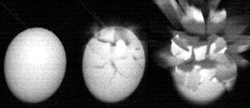The Remains of Humpty Dumpty

All the king’s horses and all the king’s men couldn’t reassemble Humpty Dumpty, but they might have at least estimated the number of pieces they had based on results reported in the 16 July PRL. To learn how shells shatter–and compare them with solid objects–researchers hurled empty eggshells against the ground and exploded others. The fragment sizes from both types of destruction followed a similar pattern and matched that of a computer simulation, suggesting that all shell-like structures may fragment in a similar way. The researchers hope to use the results to estimate the amount of spacecraft debris in orbit and to analyze mass redistribution following a supernova.
A better understanding of how materials fragment would help the military, miners, and demolition crews design explosions; it would also help forensic scientists reconstruct the details of an explosion from its aftermath. Researchers characterize the fragments of an explosion with a “distribution” plot showing the number of particles for each particle size. The plot is usually a “power law,” which means that–unlike the standard “bell curve”–there’s no average fragment size. The number of particles increases continuously as you look at smaller and smaller sizes. For a power-law exponent of 1.0, for example, halving the size doubles the number of fragments. Many studies–from examining moon craters to exploding coal–suggest that the exponent that describes the power law is “universal,” depending only on the number of dimensions of the object and independent of its size, material, and explosion energy.
Most research has focused on three-dimensional solid blocks, which have an exponent of about 2.5, or two-dimensional steel plates, whose exponent is between 1.5 and 2. But some researchers have wondered whether objects such as gas tanks and buildings could obey a different power law because they are shell-shaped. Cracks in shells propagate essentially in two dimensions like a metal plate, but the shell moves and deforms in three dimensions like a solid block. To see how shells fragment, Ferenc Kun of the University of Debrecen in Hungary, Falk Wittel of the University of Stuttgart in Germany, and their colleagues, drilled small holes in the top and bottom of ordinary brown and white eggs, blew their contents out, and dried them. The researchers then placed each egg inside a large, sealed plastic bag and either catapulted it against the ground or filled it with hydrogen and detonated it. The team then spread each set of debris onto a flatbed scanner to record the particle sizes.
The fragments from both experiments obeyed a power law with an exponent of 1.35–compared with the solid object value of 2.5–for pieces smaller than about one thousandth of the total area of the eggshell. The smaller exponent for these shells means that they generated more small particles than solid objects would. To find out if other shell-like objects behave similarly, Kun and his colleagues created computer simulations for the two kinds of break-up for spherical shells that were softer than eggshells. Both simulation power laws matched those of the eggshells for small fragment sizes, suggesting that the shell power law may be universal. Building on this work, Kun hopes to determine the mass and velocity distribution of space debris from satellites and rockets.
“I find these experiments on eggshells quite ingenious and the results quite impressive,” says Donald Turcotte of the University of California, Davis. Impacts and internal explosions are very different events, he says. “It is not obvious the results would have been so similar.”
–JR Minkel
JR Minkel is a freelance science writer in New York City.
More Information
Focus story on previous work by Kun from 22 March 1999


